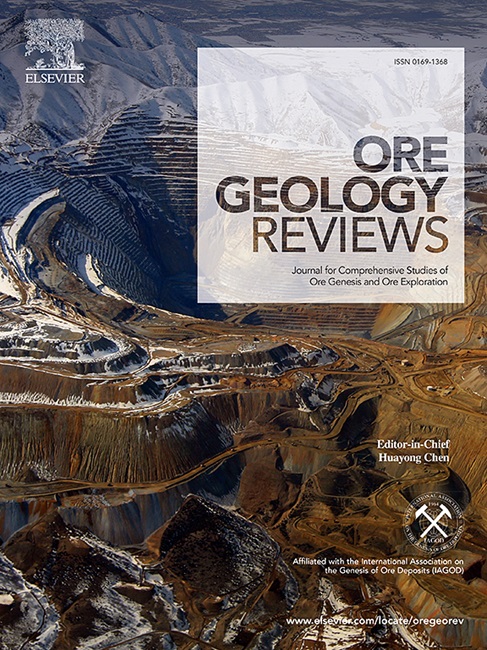Bonanza-type epithermal Ag-Au mineralisation in Nová Baňa (Western Carpathians, Slovakia)
IF 3.2
2区 地球科学
Q1 GEOLOGY
引用次数: 0
Abstract
The Miocene bonanza-type epithermal mineralisation Šibeničný vrch is located in the western part of the historic Nová Baňa deposit on the western slope of the Štiavnica stratovolcano. In the near-surface primary samples, bonanza accumulations contain up to 1700 ppm Ag and 283 ppm Au, while the Cu content does not exceed 59 ppm. This unusual geochemical signature, where Au exceeds Cu, Pb, or Zn, led to formation of unique mineral association in the studied samples. In this work, we focus on this mineral assemblage and its formation. The bonanza ores are banded, with rhythmically alternating chalcedony, quartz with enclosed adularia, and irregular accumulations of precious-metal minerals. The mineral assemblage hosted in the near-surface samples comprises pyrite, rozhdestvenskayaite-(Zn), zvěstovite-(Zn), zvěstovite-(Fe), argentopolybasite, argentopearceite, auropolybasite, auropearceite, Au-Ag alloys, stephanite, selenostephanite, pyrargyrite, proustite, naumannite, uytenbogaardtite, iodargyrite, and bromargyrite. These minerals document high concentration of Au, Ag, Sb, As, Se, and S in the fluid, simultaneously with lack of Cu, Pb, and Zn. Some of these sulfides incorporated Au in their structure, even though under usual geochemical conditions, they would not do so. The deeper parts of the same vein (163–166 m below the current surface) are characterised by lower Au and Ag contents (<84 ppm Ag, <6.95 ppm Au) and the mineral assemblage of chalcopyrite, galena, sphalerite, Au-Ag alloys, polybasite, and pearceite. Ore-bearing colloform bands of chalcedony consist of various textures, predominantly mosaic, acicular/pseudoacicular, flamboyant, or moss textures. We assume that the genesis of these chalcedony forms is related to the fluid boiling. Crustiform quartz in the deeper parts of the vein is most likely related to fluid mixing. Two possible metal transport mechanisms were cooperating in the ore-forming processes, either in bisulfide complexes or in the form of colloids (nanoparticles). Precious-metal enrichment and gangue in studied bonanza-type mineralisation links to the combination of vigorous boiling of the fluid and fluid mixing with meteoric water in the sub-surface environment. Hydrothermal breccias range from small enclaves within veinlets in the deeper parts of the studied mineralisation, but extend vertically to form pipelike body in the uppermost parts. The widespread hydrothermal breccias show that boiling was more intensive in the near-surface zone. In contrast, fluid mixing likely triggered metal precipitation in the deeper parts of the deposit.

求助全文
约1分钟内获得全文
求助全文
来源期刊

Ore Geology Reviews
地学-地质学
CiteScore
6.50
自引率
27.30%
发文量
546
审稿时长
22.9 weeks
期刊介绍:
Ore Geology Reviews aims to familiarize all earth scientists with recent advances in a number of interconnected disciplines related to the study of, and search for, ore deposits. The reviews range from brief to longer contributions, but the journal preferentially publishes manuscripts that fill the niche between the commonly shorter journal articles and the comprehensive book coverages, and thus has a special appeal to many authors and readers.
 求助内容:
求助内容: 应助结果提醒方式:
应助结果提醒方式:


